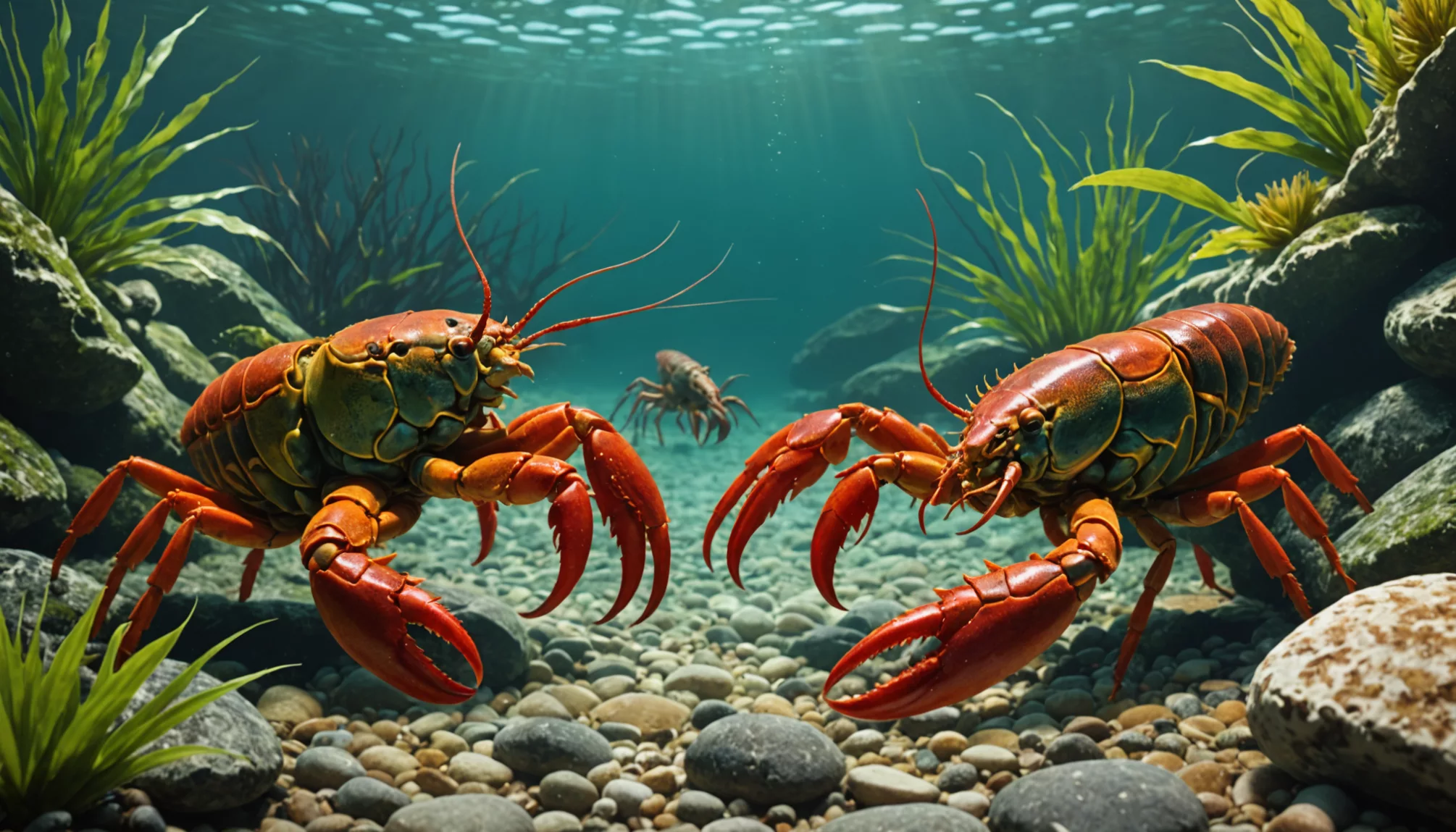Crayfish are not just cute little creatures scuttling around your aquarium; they have fascinating differences between the boys and girls! Knowing how to tell male from female crayfish is key for any aspiring aquarium hobbyist. If you can’t spot these differences, you might end up with a tank full of surprises, like unexpected baby crayfish!
In this article, you’ll discover how to distinguish male and female crayfish by examining their abdomens, claws, and swimmerets. We’ll explore the unique physical traits that set them apart and why understanding their gender is important for a healthy aquarium ecosystem. So, let’s dive in and unlock the secrets of crayfish gender—your underwater friends are waiting to reveal their true colors!
How to Tell Male From Female Crayfish

Understanding Crayfish Gender Differences
Crayfish are fascinating freshwater creatures found in rivers, lakes, and ponds. Identifying their gender is key to proper care. Males and females differ in physical traits. Males usually have larger claws used for attracting mates and self-defense. Females possess reproductive features to carry eggs. Recognizing these differences assists in aquarium management.
Key Features to Distinguish Male and Female Crayfish
To determine crayfish gender, focus on these features:
- Claw Size: Male crayfish have larger claws, known as chelae, for displays and fights.
- Swimmerets: Males have a special third pair of swimmerets called gonopods for reproduction, while females’ swimmerets are well-developed to hold eggs.
Here’s a table of these features:
| Feature | Male Crayfish | Female Crayfish |
|---|---|---|
| Claw Size | Larger claws (chelae) | Smaller claws |
| Swimmerets | Modified for mating | Developed for egg care |
The Importance of Knowing Crayfish Gender
Knowing crayfish gender is important for:
- Breeding: Successful breeding needs knowledge of gender. A typical ratio is one male for two females.
- Aquarium Dynamics: Mating behaviors vary, affecting tank balance. Knowing gender helps manage these dynamics.
- Ecosystem Health: A balanced gender ratio reduces aggression and supports a stable aquarium ecosystem.
Understanding these physical differences is essential for the care and breeding of crayfish in aquariums.
Identifying Male and Female Crayfish Based on Abdomen

Understanding how to tell male from female crayfish is important for aquarists. The abdominal area offers clear clues to distinguish their gender. This guide will help you compare their abdominal size, shape, and reproductive roles.
Comparing the Abdomen Size of Male and Female Crayfish
The abdomen size is a noticeable difference between male and female crayfish.
- Male crayfish: They have a narrower and longer abdomen. This shape is easy to spot from above and allows them to move and grasp during mating.
- Female crayfish: Their abdomen is broader and shorter. This shape is perfect for carrying eggs, which is vital for reproduction.
| Gender | Abdomen Size | Description |
|---|---|---|
| Male | Narrower and longer | Helps in mobility and mating |
| Female | Broader and shorter | Designed for egg carrying |
Recognizing Unique Abdomen Shapes in Crayfish
Besides size, the shape of the abdomen is crucial for identification.
- Males: Their abdomen is pointed or tapered, which helps in securely grasping females during mating.
- Females: They have a more rounded abdomen to accommodate eggs.
Recognizing these shapes helps in quickly identifying the sex of crayfish in an aquarium.
Abdominal Characteristics Related to Reproductive Roles
The crayfish abdomen plays a major role in reproduction.
- Females: The third pair of legs, or pleopods, are adapted to carry and protect eggs until they hatch.
- Males: The fifth pair of legs is used for transferring sperm to females.
| Gender | Reproductive Role | Characteristics |
|---|---|---|
| Male | Sperm transfer | Fifth pair of legs adapted for sperm transfer |
| Female | Egg brooding | Third pair of legs adapted for carrying eggs |
Citation
Analyzing Claw Features to Determine Crayfish Gender

Understanding how to tell male from female crayfish is key for aquarists and researchers. The claws of crayfish, also known as chelae, provide important clues. These features help identify gender and reveal much about mating and dominance behaviors. This section explores how claw size, characteristics, and strength indicate crayfish gender.
The Role of Claw Size in Male and Female Crayfish
Claw size is a clear indicator of gender in crayfish. Typically, male crayfish have larger claws than females. These larger claws serve several purposes:
- Mating Rituals: Males use their bigger claws to hold females during mating, ensuring successful reproduction (Wikipedia: Rusty crayfish).
- Dominance: Larger claws often show dominance among males. Males with big claws can intimidate rivals, increasing their chances of mating.
Claw size differences can vary by species. For example, rusty crayfish show significant differences in claw size between genders (Wikipedia: Crayfish).
How Claw Characteristics Affect Mating Strategies
Claw characteristics, beyond size, are vital in crayfish mating strategies. Shape and strength also play roles:
- Courtship Displays: Males may wave or clash their claws to attract females, demonstrating their strength and vitality.
- Territorial Behavior: Males with strong claws often secure better territories. This can lead to more mating opportunities, as females prefer strong males who can defend resources.
Research shows that claw traits can influence reproductive success in crayfish populations. Larger claws often correlate with greater mating success.
Assessing Claw Strength and Its Gender Implications
Claw strength is another factor in determining crayfish gender. Stronger claws can indicate a male’s fitness and mating ability:
- Physical Competition: Strong claws help males compete with others, often in physical confrontations.
- Mating Opportunities: Males with stronger claws may deter rivals and attract more females, crucial for passing on genes, especially in skewed sex ratios like 1 male to 2 females.
In conclusion, claw strength shows a male’s ability to thrive and succeed in mating. Understanding these aspects is important for aquarists aiming to breed crayfish effectively and maintain a balanced ecosystem.
Examining Swimmerets to Distinguish Male and Female Crayfish

What Are Swimmerets? An Overview
Swimmerets, or pleopods, are tiny leg-like parts on the abdomen of crayfish and other crustaceans. They serve several important purposes:
- Swimming: Swimmerets help crayfish move through water. They create a current that pushes the crayfish forward.
- Brooding: Female crayfish have wider and flatter swimmerets to carry and protect their eggs until they hatch.
- Feeding: Swimmerets aid in gathering food. They direct food toward the mouth, ensuring the crayfish gets enough to eat.
Understanding these roles is key to telling apart male and female crayfish since swimmerets show distinct gender differences.
Male vs. Female Swimmeret Differences
The differences in swimmerets between males and females are noticeable and aid in identifying gender:
- Structure: Female crayfish have the first two pairs of swimmerets that are wide and flat for holding eggs. Male swimmerets are slender and designed for reproduction.
- Functionality: Males have their first pair of swimmerets modified into gonopods, which are essential for transferring sperm during mating.
The Role of Swimmerets in Crayfish Reproductive Behavior
Swimmerets are crucial in crayfish mating and reproduction:
- Mating: Males use their uniquely shaped swimmerets to transfer sperm to females. This structure ensures successful fertilization.
- Egg Care: Female swimmerets hold and protect the eggs after fertilization, providing needed care and oxygen until they hatch.
The reproductive role of swimmerets highlights their importance beyond simple movement. Recognizing these functions helps identify the gender and reproductive status of crayfish.
Size and Mating Behaviors in Adult Male and Female Crayfish

Average Size: Do Male or Female Crayfish Grow Larger?
Male crayfish usually grow larger than their female counterparts. They can reach up to 17.5 cm (6.9 inches) in length. This size difference helps males during mating and in defending their territory. Male crayfish use their robust build to compete for mates and protect their area from other males. Identifying these physical differences is key to understanding how to tell male from female crayfish.
Mating Rituals and Gender Dynamics in Crayfish
Crayfish mating involves intricate behaviors. Males display strength and size to attract females, often using their larger claws to dominate rivals. This includes swimming beside the female and gently touching her with their claws. These actions demonstrate the male’s suitability as a mate, helping to form a bond with the female. Recognizing these behaviors can help crayfish owners provide the right environment in aquariums.
Insights into Crayfish Reproductive Cycles
Crayfish have specific breeding seasons that vary with species and conditions. Female crayfish carry fertilized eggs in a brood pouch under their tails until they hatch. The cycle depends on factors like water temperature and food availability, which affect the health of both genders. Warmer water can increase breeding, leading to more offspring. Understanding these cycles aids aquarists in managing crayfish breeding and care.
References
Conclusion
Now that you know how to tell male from female crayfish, you can impress your friends with your new skills! Remember, looking at the abdomen shape and claw size are key features to distinguish between the two genders. Also, don’t forget to check the swimmerets, as they play a big role in crayfish reproduction. Understanding these differences not only helps you take better care of your aquarium but also makes you a more informed crayfish owner!
So, dive deeper into the fascinating world of crayfish! There’s always more to learn about these amazing creatures, their behaviors, and their habitats. Keep exploring, and let your curiosity swim free!
FAQs
1. Does size indicate a crayfish’s gender?
No. While males may have larger claws, size is not a reliable indicator of gender. Specific physical features are more accurate.
2. Can I determine a crayfish’s gender by its color?
Absolutely not. Crayfish color can vary due to environmental factors, diet, and genetics. It is not a reliable method for sexing crayfish.
3. Are swimmerets the same in male and female crayfish?
No. Male crayfish possess specialized swimmerets used for reproduction. This is a key distinguishing feature.
4. Is it okay to keep male and female crayfish together in the same tank?
Yes, but with caution. Male crayfish can exhibit dominant behavior, especially during mating season.
5. What is the ideal ratio of males to females in a crayfish tank?
A good ratio is one male to two or three females. This helps to minimize aggression and maintain a more peaceful environment.



